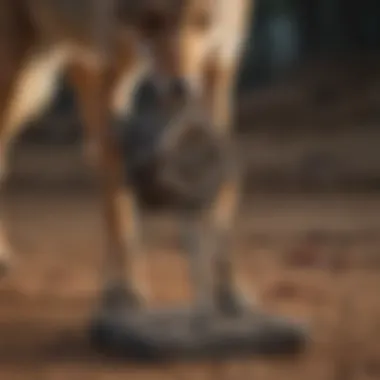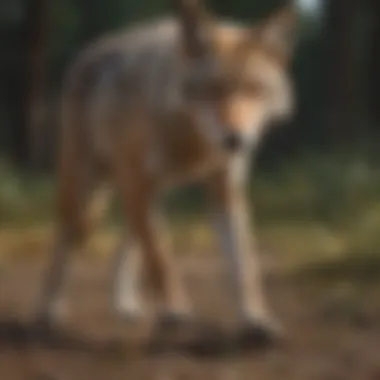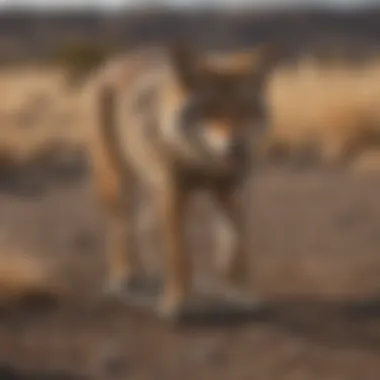Exploring the Intricacies of Coyote Leg-Hold Traps: A Comprehensive Insight


Overview of the Topic
Coyote leg-hold traps exist as intricate tools that have sparked significant debate in the realms of wildlife management and conservation. These devices, designed to capture coyotes by clamping onto their legs upon triggering, have a long history entwined with issues of efficacy, ethics, and animal welfare. Understanding the mechanisms and implications of these traps necessitates a closer look at their historical context and the contrasting perspectives that shape contemporary discussions.
Current Status and Challenges
The current landscape surrounding coyote leg-hold traps is fraught with controversies and conflicting ideologies. While proponents argue for their necessity in controlling coyote populations and safeguarding livestock, opponents highlight the cruel and indiscriminate nature of these traps, often leading to unintended casualties and suffering among non-target species. Moreover, the emergence of more humane alternatives has heightened scrutiny on the continued use of leg-hold traps, raising questions about their sustainability and ethical implications.
Sustainable Solutions
In response to mounting concerns over the ethical and ecological repercussions of coyote leg-hold traps, initiatives promoting sustainable practices and innovative solutions have gained momentum. From the development of advanced trap technologies that minimize harm to non-target animals to the implementation of stricter regulations on trap usage, efforts are being made to mitigate the negative impacts associated with trapping methods. By advocating for responsible trapping practices and exploring alternative approaches, conservationists and wildlife biologists strive to strike a balance between wildlife management and animal welfare.
Impact and Importance
The impact of coyote leg-hold traps extends beyond individual animals to encompass larger ecological dynamics and societal attitudes towards wildlife conservation. Ecosystem disruptions caused by excessive trapping can ripple through food chains, affecting biodiversity and ecosystem resilience. Moreover, the ethical considerations surrounding trap use underscore the importance of fostering a harmonious relationship between human activities and wildlife preservation. Recognizing the interconnectedness of conservation efforts and sustainable resource utilization is paramount in safeguarding biodiversity for future generations.
Introduction to Coyote Leg-Hold Traps
Delve into the realm of coyote leg-hold traps, a topic that navigates the historical origins, intricate mechanisms, and ethical quandaries surrounding these devices. This article serves as a comprehensive guide shedding light on the significance of understanding coyote leg-hold traps, catering to conservationists, students, and environmentalists.
Historical Origins of Leg-Hold Traps
The evolution of trapping practices
Tracing the lineage of trapping practices unveils a narrative steeped in tradition and adaptation over time. The gradual evolution of these techniques has played a pivotal role in shaping the utilization of leg-hold traps. Emphasizing the historical context enriches the narrative, offering insights into the pragmatic evolution of trapping methods.
Impact on wildlife populations


The utilization of leg-hold traps has not been without consequences on wildlife populations. Understanding the implications on various species is crucial for assessing the broader impact of such practices. Analyzing the repercussions sheds light on the intricate balance between human activities and ecological systems.
Mechanisms of Coyote Leg-Hold Traps
Understanding the design
Deconstructing the design of coyote leg-hold traps unravels a complex interplay of engineering precision and functional necessity. Delving into the specifics of design elucidates the nuances that render these traps effective yet contentious. By dissecting the design elements, a comprehensive comprehension of the mechanisms at play is achieved.
Functionality and efficiency
Evaluated through the lens of functionality and efficiency, coyote leg-hold traps present a dual narrative of practicality and ethical scrutiny. Unveiling the intricacies of their operation provides a holistic view of their impact on target species and unintended consequences. Placing emphasis on functionality and efficiency allows for a nuanced discussion on the efficacy of such trapping mechanisms.
Legal Regulations and Ethical Considerations
Current legislation on trap usage
Navigating the legal landscape surrounding trap usage delves into the regulatory frameworks that govern the deployment of coyote leg-hold traps. Understanding the existing legislation sheds light on the mechanisms in place to mitigate potential environmental risks and animal welfare concerns. Synthesizing the legal landscape underscores the intersection of conservation efforts and legal compliance.
Debates on ethical implications
Unpacking the ethical implications of using leg-hold traps ignites debates that question the morality of such practices. Evaluating the ethical dimensions offers a nuanced perspective on the intersection of human activities and wildlife conservation. Nurturing a discourse on ethical implications fosters a critical examination of the ethical underpinnings inherent in using coyote leg-hold traps.
Impacts of Coyote Leg-Hold Traps
In this article, focusing on the impacts of coyote leg-hold traps is crucial for understanding the broader implications of predator control strategies. By delving into the ecological effects, animal welfare concerns, and human dimensions associated with these traps, we can gain a comprehensive perspective on the multifaceted issues at hand. Exploring the intricate web of relationships between these traps and their surrounding ecosystems is paramount to informing conservation efforts and ethical wildlife management practices.
Ecological Effects
Non-target species impact


The non-target species impact of coyote leg-hold traps is a significant aspect to consider when evaluating the effectiveness and consequences of trap usage. This particular facet underscores the unintended repercussions that such traps can have on wildlife populations beyond the intended target species. By examining how non-target species are affected by these traps, we can better grasp the broader ecological implications and disruptions caused by trapping practices. Understanding the intricate dynamics between predator and prey species is essential for formulating more sustainable and balanced wildlife management strategies.
Disruption of ecosystems
Moreover, the disruption of ecosystems resulting from coyote leg-hold traps is an essential consideration in mitigating the potential cascading effects of trapping activities. The intricate interplay between various species within an ecosystem can be heavily impacted by the removal or disturbance of key predators like coyotes. By analyzing how ecosystem dynamics are altered by the use of leg-hold traps, we can assess the long-term consequences and ecological imbalances that may arise. Recognizing the intricate relationship between predators, prey, and their habitats is vital for promoting biodiversity and ecosystem resilience in the face of human interventions.
Animal Welfare Concerns
Pain and suffering of trapped animals
The pain and suffering experienced by animals caught in leg-hold traps highlight the ethical dilemmas and welfare concerns associated with such trapping methods. Understanding the physical and psychological distress inflicted upon trapped animals sheds light on the ethical considerations of using these devices. By delving into the experiences of these animals, we can empathize with their plight and advocate for more humane and effective wildlife management practices.
Long-term consequences on wildlife
Furthermore, the long-term consequences on wildlife stemming from leg-hold traps underscore the need for sustainable and ethical approaches to predator control. Examining how prolonged trapping activities impact wildlife populations over time reveals the enduring challenges faced by ecosystems and species resilience. By analyzing the lasting effects of trapping on wildlife, we can better appreciate the intricate connections between human actions and ecological outcomes. Addressing the long-term consequences of trapping is essential for conserving biodiversity and promoting ecosystem health in the long run.
Human Dimensions
Impact on indigenous communities
The impact of coyote leg-hold traps on indigenous communities is a critical aspect that illuminates the intersection of cultural heritage, conservation practices, and social justice. Recognizing how trapping activities affect indigenous peoples' traditional territories and livelihoods is essential for fostering inclusive and equitable conservation efforts. By examining the implications for indigenous communities, we can better understand the complex dynamics of predator control and indigenous rights within the broader context of environmental conservation.
Public perception and advocacy
Additionally, public perception and advocacy surrounding coyote leg-hold traps play a pivotal role in shaping policy decisions and wildlife management practices. Analyzing how public attitudes and advocacy efforts influence the debate around trapping sheds light on the social dimensions of conservation. By exploring public perceptions and advocacy campaigns related to trapping, we can gauge the effectiveness of communication strategies and community engagement initiatives. Understanding the human dimensions of trapping is essential for promoting informed decision-making and fostering collaborative conservation efforts.
Alternatives to Coyote Leg-Hold Traps


In the discourse surrounding coyote leg-hold traps, the exploration of alternatives to these controversial trapping methods becomes paramount. As the article scrutinizes the intricacies of coyote leg-hold traps, it also sheds light on the significance of seeking alternative practices for wildlife management. Understanding and implementing alternatives not only align with ethical considerations but also contribute to more sustainable wildlife conservation efforts. By delving into non-lethal wildlife management strategies, this section offers insights into fostering coexistence and implementing technological innovations to mitigate the adverse impacts of trapping on biodiversity.
Non-lethal Wildlife Management Strategies
Encouraging Coexistence
Within the realm of non-lethal wildlife management strategies, promoting the concept of encouraging coexistence emerges as a crucial component. This approach emphasizes creating habitats and ecosystems where both humans and wildlife can thrive harmoniously. Encouraging coexistence encourages a proactive stance towards wildlife management, promoting respect for diverse species' natural behaviors and habitats. The interactive nature of this strategy fosters a symbiotic relationship between wildlife and human communities, promoting long-term sustainability and conservation.
Technological Innovations
Technological innovations play a pivotal role in revolutionizing wildlife management practices, offering efficient and humane solutions to wildlife-human conflicts. By leveraging cutting-edge technologies such as non-invasive monitoring methods, GPS tracking, and thermal imaging, wildlife managers can enhance their surveillance and research capabilities. The integration of technology not only boosts the effectiveness of conservation efforts but also minimizes the need for traditional trapping methods. However, it is essential to consider the potential limitations and costs associated with adopting technological innovations in wildlife management frameworks.
Community-Based Conservation
Engaging Stakeholders
Community-based conservation strategies highlight the importance of involving local communities and stakeholders in wildlife management decisions. Engaging stakeholders fosters a sense of ownership and responsibility among community members, leading to increased participation in conservation initiatives. By incorporating traditional ecological knowledge and local perspectives, conservation efforts become more culturally relevant and sustainable. However, the success of engaging stakeholders hinges on effective communication, collaboration, and transparent decision-making processes.
Empowering Local Initiatives
Empowering local initiatives empowers communities to spearhead conservation projects tailored to their specific needs and priorities. This decentralized approach enhances local capacity building and fosters a sense of stewardship towards natural resources. By providing training, resources, and support to local initiatives, conservation organizations can catalyze grassroots conservation movements. Empowering local communities not only safeguards biodiversity but also promotes social inclusivity and empowerment within conservation agendas.
Conclusion:
In concluding the discussion on coyote leg-hold traps, it is imperative to reflect on the multifaceted implications and the intricate nature of these traps. The significance of this section lies in synthesizing the various aspects covered in the preceding parts of the article, providing a holistic view of the topic. By examining the historical origins, mechanisms, impacts, and alternatives to these traps, we can gain a comprehensive understanding of their use and controversies. Through a critical lens, we can discern the ethical considerations and legal regulations surrounding coyote leg-hold traps, shedding light on the need for sustainable and humane wildlife management practices.
Reflecting on the Future of Trapping Practices:
Sustainability in Wildlife Management:
Delving into the realm of sustainability in wildlife management unveils a crucial aspect of conservation efforts that resonates deeply with the discourse on coyote leg-hold traps. The essence of sustainability lies in its ability to promote long-term ecological balance and harmony while preserving biodiversity. Sustainable practices prioritize the well-being of ecosystems and wildlife populations, emphasizing the importance of coexistence and responsible stewardship. Harnessing sustainable principles in trapping practices offers a viable path towards minimizing environmental impact and fostering a more harmonious relationship between humans and wildlife.
Balancing Conservation and Human Interests:
The delicate balance between conservation objectives and human interests forms the crux of ethical dilemmas surrounding coyote leg-hold traps. By addressing this dichotomy, we confront the challenge of mitigating conflicts between wildlife preservation and human livelihoods. Striking a harmonious equilibrium requires careful consideration of both ecological and societal concerns, ensuring that conservation efforts are sustainable and inclusive. Balancing these interests necessitates collaborative decision-making, stakeholder engagement, and adaptive management approaches to navigate the complexities of wildlife conservation effectively.



